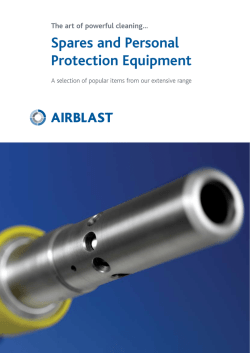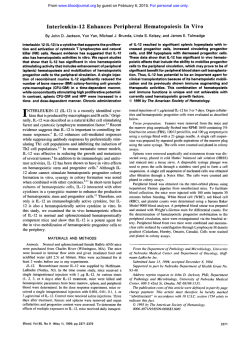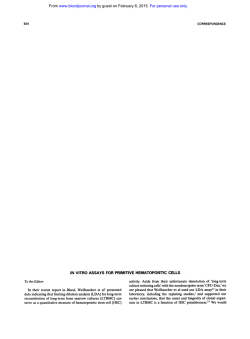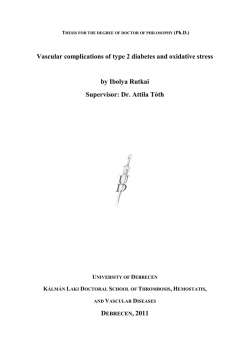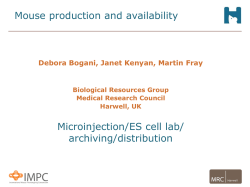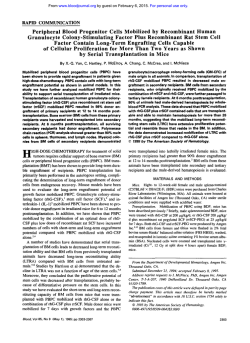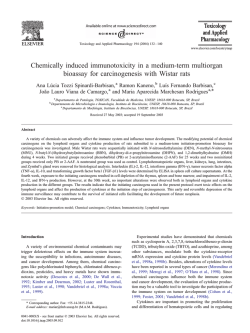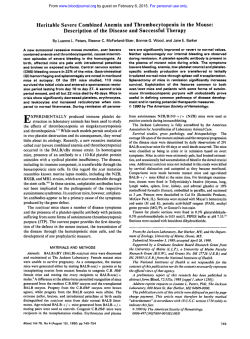
In Vivo Stem Cell Function of Interleukin-3-Induced Blast Cells
From www.bloodjournal.org by guest on February 6, 2015. For personal use only. In Vivo Stem Cell Function of Interleukin-3-Induced Blast Cells By Jun-lchi Tsunoda, Seiji Okada, Junko Suda, Kazunari Nagayoshi, Hiromitsu Nakauchi, Kiyohiko Hatake, Yasusada Miura, and Toshio Suda The treatment of mice with high doses of 5-fluorouracil (5-FU) results in an enrichment of primitive hematopoietic progenitors. Using this procedure, we obtained a new class of murine hematopoietic colonies that had very high secondary plating efficiencies in vitro and could differentiate into not only myeloid cells but also into lymphoid lineage cells. The phenotypes of interleukin-3 (IL-3) induced blast colony cells were Thy-l-positive and lineage-marker-negative. We examined whether these blast colony cells contained primitive hematopoietic stem cells in vivo and could reconstitute hematopoietic tissues in lethally irradiated mice. Blast colony cells could generate macroscopic visible spleen colonies on days 8 and 12, and 5 x lo3 blast cells were sufficient t o protect them from lethally irradiation. It was shown that 6 or 8 weeks after transplantation of 5 x I O a blast cells, donor male cells were detected in the spleen and thymus of the female recipients but not in the bone marrow by Southern blot analysis using Y-encoded DNA probe. After 10 weeks, bone marrow cells were partially repopulated from donor cells. In a congenic mouse system, donor-derived cells (Ly5.2) were detected in the thymus and spleen 6 weeks after transplantation. Fluorescence-activated cell sorter analyses showed that B cells and macrophages developed from donor cells in the spleen. In the thymus, donor-derived cells were found in CD4, CD8 double-positive, single-positive, and double-negative populations. Reconstitution of bone marrow was delayed and myeloid and lymphoid cells were detected 10 weeks after transplantation. These results indicate that IL-3-induced blast cells contain the primitive hematopoietic stem cells capable of reconstituting hematopoietic organs in lethally irradiated mice. 0 1991by The American Society of Hematology. H (5-FU) DNA. In addition, we used Ly-5 congenic mice for the analysis of hematopoietic reconstitution by blast colony cells. We found that blast colony cells with extensive proliferative potential could generate macroscopic spleen colonies by days 8 and 12, provide protection from lethal irradiation, and reconstitute hematopoietic tissues in vivo. ODGSON AND BRADLEY found that the treatment of mice with high doses of 5-fluorouracil resulted in an enrichment of primitive hematopoietic progenitors.’ Using this procedure, it was reported that interleukin-3 (IL-3) induced a new class of murine hematopoietic colonies, termed blast cell colonies, which had extremely high secondary plating efficiency’ and could differentiate into not only myeloid-lineage but also into lymphoid-lineage cells in vitro.’ Although the differentiation and proliferation capacity of blast colony cells was well examined in vitro, this potential was not well examined in vivo. In this study, we tried to clarify whether or not blast colony cells contained primitive hematopoietic stem cells. Hematopoietic stem cells are defined as cells that give rise to all lineages of hematopoietic cells, have the ability to maintain hematopoiesis in the long t e m , and have the ability of self-renewal. In vivo hematopaietic stem cells are determined using the spleen colony assay (colony-forming unit-spleen [CFU-SI), the 30-day radioprotection assay, and by determining their marrow repopulating ability. Using Y-encoded DNA probe6 when male cells are transplanted into female mice the presence of male cells in the myeloid and lymphoid tissue of reconstituted female recipients can be assayed by Southern blot analysis of extracted From the Division of Hematology, Department of Medicine, Jichi Medical School, Tochigi-ken,Japan; and the Laboratov of Molecular Regulation of Aging, Frontier Research Prokam, The Institute of Physical and Chemical Research (Riken), Tsukuba, Japan. Submitted November 21,1990; accepted March 19, 1991. Supported in part by Grants-in-Aidfrom the Ministry of Education, Science and Culture of Japan. Address reprint requests to Toshio Suda, MD, Division of Hematol00,Department of Medicine, Jichi Medical School, Minamikawachimachi, Tochigi-ken,329-04, Japan. The publication costs of this article were defrayed in part by page charge payment. This article must therefore be hereby marked “advertisement” in accordance with 18 U.S.C.section 1734 solely to indicate this fact. 0 1991 by The American Society of Hematology. 0006-497119117802-0020$3.0010 318 MATERIALS AND METHODS Animals. Male and female BDFl (C57BLl6 x DBA/2) mice, 8 to 10 weeks old, were purchased from Sizuoka Laboratory Animal Center (Sizuoka, Japan). Male BDFl mice were administered 5-FU (Adria Laboratories, Colombus, OH) through the tail vein at a dosage of 150 mgkg body weight. Spleen cells were harvested 4 days later and single cell suspensions were prepared from pooled spleens. C57BLlS.Ly5.1 mice were originally provided by Dr T. Takahasi (Aichi Cancer Center, Aichi, Japan) and raised in our colony. Hematopoietic factors. Murine recombinant IL-3 (rIL-3) was obtained from the serum-free culture supernatants of COS-1 cells transfected with a clone of IL-3 gene using a PCD-X vector provided by Dr T. Yokota (DNAX Research Institute of Molecular and Cellular Biology Inc, Palo Alto, CA) with a specific activity of 10s U/mg protein.’ Blast colony cells. Methylcellulose culture was performed in 35-mm Don-tissue culture dishes (Falcon, Oxnard, CA). One milliliter of culture consisted of 1.2 X lo6 5-FU-treated spleen cells, a-minimal essential medium (a-MEM), 1.2% methylcellulose (Aldrich Chemical Company, Milwaukee, WI), 30% fetal calf serum (FCS; Flow Laboratories, North Ryde, New South Wales, Australia), 1% deionized bovine serum albumin (BSA Sigma Chemical Company, St Louis, MO), 1 x mol/L 2-mercaptoethanol (Eastman Organic Chemicals, Rochester, NY), and 100 U rIL-3. Dishes were cultured at 37°C in a fully humidified atmosphere of 5% CO, in air. After 6 to 7 days of culture, blast cell colonies were lifted with a 3-pL Eppendorf micropipette under inverted microscopy, and resuspended in a medium containing 10% FCS. Characterization of blast colony cells. Cell surface phenotype of blast colony cells was investigated by membrane staining. Blast colony cells were incubated for 30 minutes on ice with fluorescein isothiocyanate (F1TC)-, phycoerythrin (PE)-, or biotin-conjugated monoclonal antibodies (MoAbs) (Sca-1, Thy-1, Mac-1, CD4, CD8, Ly5.2) and wheat germ agglutinin (WGA).’ ’’ Sca-1 antibody was a gift from Dr Y. Aihara (Yokohama City University, Kanagawa, Blood, Vol78, No 2 (July 15), 1991: pp 318-322 From www.bloodjournal.org by guest on February 6, 2015. For personal use only. 319 FUNCTION OF INTERLEUKIN-%INDUCED BLAST CELLS Japan). Anti-Ly5.2 antibody was kindly provided by Dr H. Yakura (Tokyo Metropolitan Institute for Neurosciences, Tokyo, Japan). The specificity and origins of other MoAbs used in this study are as For stainingwith biotinylated antibodies, PE- or Texas de~cribed.'~ Red (TR)-coupled streptoavidin was used as secondary reagent. After the final wash with staining medium (3% FCS and 0.1% sodium azide in phosphate-bufferedsaline [PBS]) twice, cells were resuspended in staining medium supplemented with propidium iodide (1 &mL), and were analyzed by a FACStarP'"s (Becton Dickinson, Mountain View, CA). Multiparameter data were collected and analyzed using FACS-DESK (Version 1.8) run on a Digital Micro VAX-111, configured as de~cribed.'~ The dead cells stained with propidium iodide were gated out by FACS at the time of analysis. CFU-S assay. The number of spleen colonies was examined by the modified method of Till and M~Culloch.'~~'~ All recipients were female mice administered 9.5 Gy total body irradiation (TBI)from a dual 13'Cs source at a dose of 1.00 Gy/min. Blast colony cells were lifted up under the inverted microscope and resuspended in a-MEM.Appropriate numbers of blast colony cells were injected intravenously at 0.5 to 5 x lo3blast cells per mouse through the tail vein. The recipient female mice were killed on days 8 and 12. Spleens were removed and fixed in Bouin's solution, and spleen colonies were counted under a dissection microscope. As a negative control, medium was injected into irradiated mice. Protection from lethal irradiation by blast colony cells. Pooled blast colony cells were injected into each irradiated mouse at 0.5 to 5 x lo3through the tail vein. After transplantation, the percent of surviving mice was determined 30 days after the injection? As a negative control, pure medium was injected. All mice were kept in laminar air flow room conditions with the acidified drinking water at pH 2.8. All mice injected with medium died within 14 days after transplantation. DNA analysis after transplantation. To confirm that blast cell colonies contain pluripotent hematopoietic stem cells, we injected the cells obtained from male mice into irradiated female mice. DNA was purified by proteinase K digestion and phenolchloroform extraction." For Southern blot analysis, samples of male and female DNA from normal BDFl mice were used as positive and negative controls. Samples of DNA were digested with BamHI, electrophoresed through a 0.8% agarose gel, and transferred to a nitrocellulose membrane. After hybridization to pY2 probe, autoradiography was performed at -70°C with Fuji X-ray film (Fuji Photo Film Co, Ltd, Kanagawa, Japan) for 24 to 72 hours. To determine the relative contribution of host- and donorcell-derived material in each DNA sample, DNA from a known mixture of male and female BDFl mouse spleen cells was also blotted. Lymphohematopoietic repopulation of blast colony cells. Eightto 10-week-old C57BU6.Ly5.1 mice were lethally irradiated and then injected with appropriate numbers of blast cells obtained from C57BU6.Ly5.2 mice through the tail vein. Six to 10 weeks later, lymphohematopoietic reconstitution in the spleen, thymus, and bone marrow was examined by multiparameter FACS analysis using anti-Ly5.2 and other MoAbs? Although intensity of Thy-1 antigen of the blast cells was widely distributed, Thy-lhigh cells predominated. To examine the in vivo proliferative ability of blast colony cells, we injected 1 x lo) to 5 x lo) blast cells into 9.5 Gy irradiated BDFl mice and scored the number of spleen colonies on days 8 and 12 (Table 1). Simultaneously, the incidence of CFU-S in normal bone marrow and spleen cells and 5-FU-treated spleen cells was examined. As a negative control, pure medium was injected. Three thousand blast colony cells formed 13 and 6 spleen colonies on days 8 and 12, respectively. Considering that the f factor is around 0.1, 23 blast cells contain one day 8 CFU-S. The incidence of day 12 CFU-S was lower than that of day 8 CFU-S in blast colony cells as well as in untreated bone marrow cells and spleen cells, while in 5-FU-treated mouse spleen cells the incidence was reversed. We examined the survival rate of lethally irradiated mice that were transplanted with different numbers of blast cells as the assay for in vivo hematopoietic stem cell activity. When 2.5 x lo3 blast cells were transplanted, 50% of recipient mice survived for 30 days or more. Moreover, 5 x lo' blast cells were sufficient to protect mice from lethal irradiation (Fig 1). As a negative control, pure medium was injected; all such recipient mice were dead within 14 days after transplantation. To exclude the possibility that stem cells were generated from non-blast cells, we collected cells from colonies containing more mature cells and injected them into irradiated mice. The latter mice were dead within 2 weeks after transplantation and had no visible spleen colonies. To investigate the long-term hematopoiesis in each hematopoietic organ by donor cells, we analyzed hematopoietic reconstitution using the Y-specific probe pY-2 and Ly5 congenic mouse system. As positive and negative controls, DNA obtained from the thymuses of male and female mice was also assayed. Six to 10 weeks after 5 x lo) male blast cells were transplanted to female mice, the recipients' bone marrow, spleen, and thymus DNA was extracted. Six and 8 weeks after transplantation, a 10-kb pY2 band probe was observed in the spleen and thymus but not in the bone marrow. After 10 weeks, the pY-2 band was detected in the bone marrow, suggesting that hematopoietic reconstitution by blast cells occured in the spleen, thymus, and bone marrow (Fig 2). Table 1. Incidence of Day 8 and Day 12 Spleen Colonies in Normal Bone Marrow, Spleen, 5-FU-Treated Spleen Cells, and Blast Cell Colonies ~ Cells Cells RESULTS To examine the characteristics of blast colony cells, we lifted about 200 blast colonies that contained 100 to 250 cells and pooled them in each experiment. At first, we analyzed the surface phenotypes of blast colony cells. They were WGA-positive and SCA-1-positive and had no lineage markers including B220, CD4, CD8, and Mac-1. Bone marrowcells Spleen cells 5-FU spleen cellst Blast colony cells* Injected 5 5 5 3 x x x lo' lo6 loE x lo3 ~~ No. of CFU-S (means ? SD)' Day 8 Day 12 11.9 f 1.8 19.7 f 0.9 1.7 f 1.9 12.7 f 1.2 9.0 2 1.7 4.8 f 1.7 8.0 f 0.8 6.2 2 1.2 'Values representthe means 2 SD from five mice. tSpleen cells were derived from mice that had been injectedwith 150 mg of 5-FU per kilogram body weight 4 days before the harvest. *Blast cell colonies were removed and resuspended in a medium. From www.bloodjournal.org by guest on February 6, 2015. For personal use only. TSUNODA ET AL 320 I i o2 103 Lp5.2(FITC) LogFhwwceme 104 Number of Blast Cells Injected Fig 1. Thirty day. of survival of lethally irradiated mice in which various numbers of IL-3 blast colony cells were transplanted. In two performances of each experiment, five mice were examined and represent the average. Furthermore, to clarify the lineage of the cells generated from blast cells in vivo, transplantation experimcnts using congenic micc were performcd. Hematopoietic cells wcrc analysed by FACS to ascertain whcthcr thcy expressed the donor type marker, LyS.2, in each hematopoietic organ. Six wceks after transplantation, Ly5.2-positive cells wcrc dctcctcd in the splccn and thymus but not in thc bonc marrow. Ten wccks after transplantation, donor-derived cells predominated in the three organs, including the bonc marrow (Fig 3). In the bonc marrow, Mac-1-positive (myeloid), B220-positive (B cells), and Thy-1-positive (T cells) were present among the LyS.2-positivc cells 10 wceks after transplantation (data not shown). In the spleen. 6 wceks aftcr transplantation, B cells and Thy-1-positive cells 8 weeks I P 10 weeks " 10 kB Probe: pY2 Fig 2 Demonstration by Southem analysis of Vancoded DNA in bone marrow, spleen, and thymus of female mice transplanted with 5 x 10'male blast cells. Recipient mice were killed 8 or 10 weeks later. As controls, male and female DNA in thymus was blotted. At each point, three mice were analyzed in three independent experiments. - Fig 3. Lymphohematopoletic reconstitution by blast colony cells. Five thousand blast cells (C57SU6, Ly-5.2) were transplanted intravenously into lethally irradiated Ly-5 congenic mice (C57BU6, Ly-5.1). Donor-derived (Ly-5.2) cells were analyzed in bone marrow, spleen, and thymus 6 and 10 weeks later. (A) Bone marrow. (8) Spleen. IC) Thymus. I--) Control; (--) 6 weeks; (-) 10 weeks after transplantation. As a control, cells from each organ were stained with only PE and analyzed. were detected in addition to a very small number of Mac-1-positive cells (Fig4A through C). In the thymus, we detected CD4TD8' cclls, CD4TD8- cells, CD4+CD8cclls, and CD4TD8' cells in the Ly5.2-positive fraction (Fig4D through F). Figure 4F shows the phenotypes of only donor cells after gating LyS.2-positive fraction. Relativc numbers of CD4 singlc-positive and double-negativc cells were larger in donor ccll fraction compared with the subpopulation of thymic cells from untreated mice. DISCUSSION Pluripotent hematopoietic stem cells are defined as cells that give rise to all lineages of hematopoietic cells and also have self-renewal capacity?"".'" It has been shown that blast colony cclls dcrivcd from 5-FU-treated mouse splccn cells could diffcrcntiate into not only the myeloid lincagc but also into the lymphoid lineage in vitro.2AHowever, such differentiation and proliferation capacities of blast cells have not been examined in vivo. In this study, in vivo stem cell functions of blast cells were assayed by CFU-S, radiation protection, and hematopoietic reconstitution methods. Analysis of the surface phenotype of blast colony cells showed that thcy were WGA'. SCA-l*, Thy-1'. B220-, CD4-, and CD8-. This phenotype pattern is characteristic of stem cells, as reported by Spangrude et at" and Visser et al," except in so far as Thy-1 was not low but rather high in IL->induced blasts. It was reported that IL-3 induccd a Thy-1 antigen.'" A FACS clone-sorting study showed that thc Tl1y-1~'~~ fraction formed more colonies than the Thy1'" or negative fraction (Suda, unpublished data). Three thousand blast colony cells could generate about 13 and 6 macroscopic spleen colonies on day 8 and 12, respectively. Blast colony cells contain more day 8 CFU-S than day 12 CFU-S. Although the incidence of CFU-S in blast cells is 20 times higher than in untreated bone marrow cclls, the day 8 CFU-S/day 12 CFU-S ratio is not different between them. On the other hand, the ratio was reversed in 5-FU-treated mouse spleen cells, suggesting that primitive stem cells were selectively preserved in the latter. Thus, the population of IL-3-induced blast cells seems to be similar From www.bloodjournal.org by guest on February 6, 2015. For personal use only. FUNCTION OF INTERLEUKIN-%INDUCED BLAST CELLS 321 X :> Fig 4. Representative analyses of spleen (A through C) and thymus (0 through F) in a recipient 6 weeks after transplantationthat were shown in Fig 3. Five thousand blast cells (C57BU6, Lyfi.2) were transplanted intravenously into lethally irradiated Ly5.1 congeneic mice. After gating only the Ly5.Z-positive (donor origin) cells, thymic cells were analyzed for the expression of CD4 and CD8. These cells were stained with Ly5.2 (TR), Mac-1 (FITC), Thy-1 (PE), E220 (allophycocyanin), CD4 (PE), or CD8 (RTC). Thymus and spleen cells are represented by 2% probability contour plotting. At each point, three mice were examined in three independent experiments. to that of normal bone marrow cells but not to 5-FUtreated mouse spleen cells from which IL-3 blast cells were derived. To obtain a 50% survival rate in irradiated mice, 2.5 x 10' blast cells were required. Because about 3 x 10' unfractionated bone marrow cells were required: stem cells that could save the mice from lethal irradiation were enriched about 10-fold in 1L-%induced blast cells. It is shown that blast cells contain primitive hematopoietic stem cells in vivo. More mature cells derived from blast colony cells may support the recipients through the early critical days after transplantation. We cannot exclude the possibility that spleen colonies were derived from co-isolated cells but not from blast cells. However, it is considered to be unlikely because the background cells alone could not form any spleen colonies, and an approximately 20-fold enrichment of CFU-S was obtained in the fraction of blast colony cells. Long-term hematopoiesis by transplanted blast cells was confirmed using Y-specific probe and congenic mouse transplantation. From these studies, it was concluded that IL-3-induced blast cells are able to differentiate into myeloid cells, B cells, and T cells. Due to the lack of an appropriate culture system for early T cells, the capacity of IL-finduced blast cells to differentiate into T-cell lineage has not yet been shown, although CD3-positive large granular lymphocytes have been shown to develop from blast cells in the presence of macrophages and IL-2.lThis is the first demonstration that IL-finduced blast cells are not $1 j CDB(FITC) restricted to myeloid and B-cell lineages, but that they can differentiate into CD4+/CD8+cells in the thymus. The repopulation of the spleen and thymus precedes that of the bone marrow. When we transplanted WGA+Lin-cells into irradiated mice in a separate study, bone marrow was found to be reconstituted as well as the spleen and thymus within 6 weeks after transplantation."' Therefore, it was suggested that in vivo differentiation of blast cells was different from in vitro differentiation, because about 50% of 1L-finduced blast cells formed myeloid colonies in in vitro culture systems.' It remains to be clarified whether or not IL-3 affects primitive stem cells by committing them to differentiation pathways. IL-3 is shown to have a number of biologic activities; in addition to a mast cell growth-promoting activity and granulocyte/macrophagecolony-stimulating activity, lymphopoietic effects have been reported, such as pre-B-cell-stimulating activity and activity to induce an enzyme 20a-hydroxysteroid dehydrogenase in T lymphocytes.".z In conclusion, IL-finduced blast cells contained primitive hematopoietic stem cells capable of colony formation in vivo, repopulating hematopoiesis over the long term, and differentiating into myeloid and lymphoid cells in vivo. ACKNOWLEDGMENT We thank S. Kurokawa for skillful technical assistance and M. Yoshida for preparing the manuscript. REFERENCES 1. Hodgson GS. Bradley TR:Properties of haematopoietic stem 4. Suda T,Ohara A, Suda J, Okada S,Tokuyama N, Miura Y, cells surviving 5-fluorouracil treatment: Evidence for a pre-CFU-S Sudo T, Nishikawa S-I,Nakauchi H: Early B cell differentiation cell? Nature 281:381, 1979 from hematopoietic stem cells in the presence of stromal cells and interleukin-7 (IL-7). in Gorin NC. Douay L (eds): Experimental 2. Suda T, Suda J, Ogawa M: Proliferative kinetics and differentiation of murine blast cell colonies in culture: Evidence for Hematology Today-1989. New York, NY,Springer-Verlag. 1989 variahle Goperiods and constant doubling rates of early pluripo5. Kurihara N. Suda T, Miura Y, Nakauchi H. Kodama H, Hiura tent hemopoietic progenitors. J Cell Physiol 117:308,1983 K, Hakeda Y, Kumegawa M: Generation of osteoclasts from 3. Minato N, Hattori M, SudoT, Kano S, Miura Y, Suda J, Suda isolated hematopoieticprogenitor cells. Blood 74:1295, 1989 T Differentiation in vitro of T3* large granular lymphocytes with 6. Lamar EE. Palmer E: Y-encoded. species-specific DNA in characteristic cytotoxic activity from an isolated hematopoietic mice: Evidence that the Y chromosome exists in two polymorphic progenitor colony. J Exp Med 167762.1988 forms in inhred strains. Cell 37171, 1984 From www.bloodjournal.org by guest on February 6, 2015. For personal use only. 322 7. Yokota T, Lee F, Rennick D, Hall C, Arai N, Mosmann T, Nabel G, Cantor H, Arai K-I: Isolation and characterization of a mouse cDNA clone that expresses mast-cell growth-factor activity in monkey cells. Proc Natl Acad Sci USA 81:1070,1984 8. Spangrude GJ, Heimfeld S, Weissman I L Purification and characterization of mouse hematopoietic stem cells. Science 241: 58,1988 9. Scheid MP, Triglia D: Further description of the Ly-5 system. Immunogenetics 9:423, 1979 10. Dialynas DP, Wilde DB, Marrack P, Pierres A, Wall KA, Havran W, Otten G, Loken MR, Pierres M, Kappler J, Fitch F W Characterization of the murine antigenic determinant, designated L3T4a, recognized by monoclonal antibody GK1.5: Expression of L3T4a by functional T cell clones appears to correlate primarily with class I1 MHC antigen-reactivity. Immunol Rev 74:29, 1983 11. Ledbetter JA, Herzenberg LA: Xenogeneic monoclonal antibodies to mouse lymphoid differentiation antigens. Immunol Rev 47:63,1979 12. Visser JWM, Bauman JGJ, Mulder AH, Eliason JF, deLeeuw AM: Isolation of murine pluripotent hemopoietic stem cells. J Exp Med 59:1576,1984 13. Nicola NA, Burgess AW, Staber FG, Johnson GR, Metcalf D, Battye F L Differential expression of lectin receptors during hemopoietic differentiation: Enrichment for granulocyte-macrophage progenitor cells. J Cell Physiol103:217,1980 14. Moore WA, Kautz RA: Data analysis in flow cytometry, in Weir DM, Herzenberg LA, Blackwell C, Herzenberg LA (eds): The Handbook of Experimental Immunology (ed 4). Edinburgh, Scotland, Blackwell, 1986, p 30.1 15. Till JE, McCulloch EA: A direct measurement of the TSUNODA ET AL radiation sensitivity of normal mouse bone marrow cells. Radiat Res 14:213,1961 16. Magli MC, Iscove NN, Odartchenko N Transient nature of early hematopoietic spleen colonies. Nature 295527,1982 17. Maniatis T, Fritisch EF, Sambrook J: Molecular Cloning: A Laboratory Manual. Cold Spring Harbor, NY,Cold Spring Harbor Laboratory, 1982 18. Rennick DM, Lee FD, Yokota T, Arai K-I, Cantor H, Nabel GJ: A cloned MCGF cDNA encodes a multilineage hematopoietic growth factor: Multiple activities of interleukin 3. J Immunol 134:910,1985 19. Okada S, Suda T, Suda J, Tokuyama N, Nagayoshi K, Miura Y, Nakauchi H: Effects of interleukin-3, interleukin-6, and granulocyte colony-stimulating factor on sorted murine splenic progenitor cells. Exp Hematol 19:42,1991 20. Ihle JN, Keller J, Oroszlan S, Henderson LE, Copeland TD, Fitch F, Prystowsky MB, Goldwasser E, Schrader JW, Palaszynski E, Dy M, Lebel B: Biologic properties of homogeneous interleukin 3. I. Demonstration of WEHI-3 growth factor activity, mast cell growth factor activity, P cell-stimulating factor activity, colonystimulating factor activity, and histamine-producing cell-stimulating factor activity. J Immunol131:282,1983 21. Palacios R, Henson G, Steinmetz M, McKearn JP: Interleukin-3 supports growth of mouse pre-B-cell clones in vitro. Nature 309:126,1984 22. Ihle JN, Pepersack L, Rebar L: Regulation of T cell differentiation: In vitro induction of 20u-hydroxysteroid dehydrogenase in splenic lymphocytes from athymic mice by a unique lymphokine. J Immunol 126:2184,1981 From www.bloodjournal.org by guest on February 6, 2015. For personal use only. 1991 78: 318-322 In vivo stem cell function of interleukin-3-induced blast cells J Tsunoda, S Okada, J Suda, K Nagayoshi, H Nakauchi, K Hatake, Y Miura and T Suda Updated information and services can be found at: http://www.bloodjournal.org/content/78/2/318.full.html Articles on similar topics can be found in the following Blood collections Information about reproducing this article in parts or in its entirety may be found online at: http://www.bloodjournal.org/site/misc/rights.xhtml#repub_requests Information about ordering reprints may be found online at: http://www.bloodjournal.org/site/misc/rights.xhtml#reprints Information about subscriptions and ASH membership may be found online at: http://www.bloodjournal.org/site/subscriptions/index.xhtml Blood (print ISSN 0006-4971, online ISSN 1528-0020), is published weekly by the American Society of Hematology, 2021 L St, NW, Suite 900, Washington DC 20036. Copyright 2011 by The American Society of Hematology; all rights reserved.
© Copyright 2025
